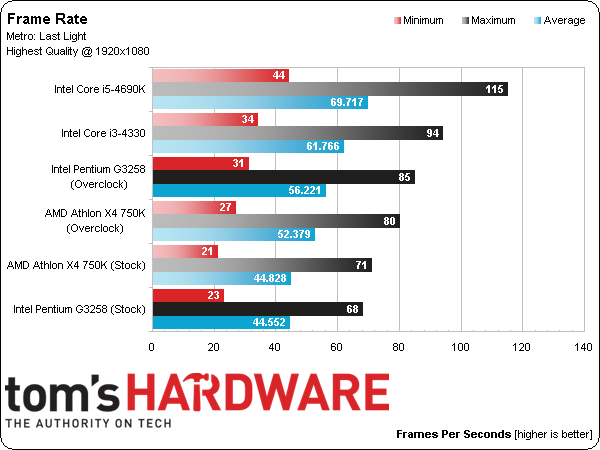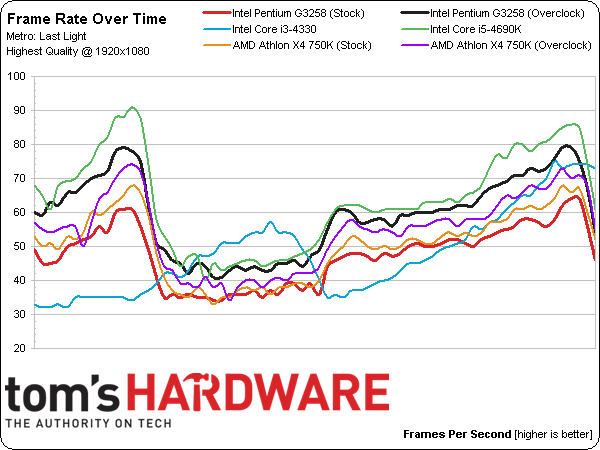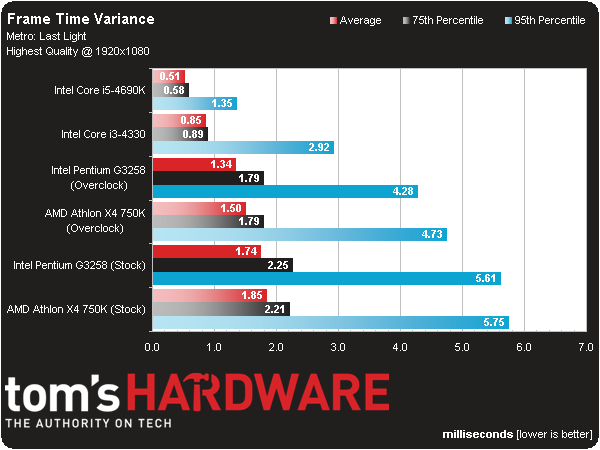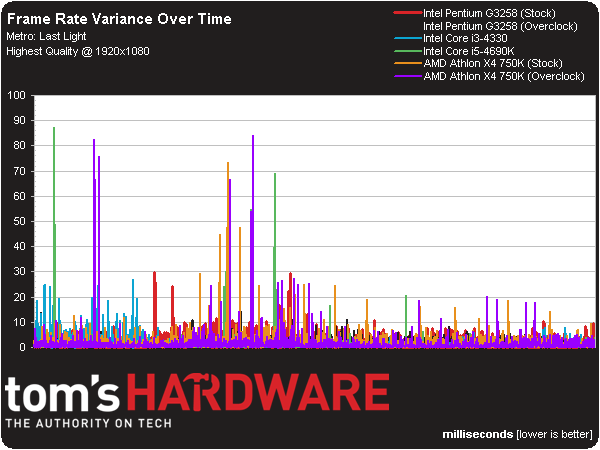Intel Pentium G3258 CPU Review: Haswell, Unlocked, For $75
It's a momentous occasion. Intel now offers an affordable dual-core Pentium with an unlocked multiplier based on its Haswell architecture. How well does it overclock? Can it beat AMD's potent little Athlon X4 750K? We run both through our benchmark suite.
Results: Metro: Last Light
This one took me by surprise. Metro typically shows itself to be quite demanding of graphics resources. But at a Very High DirectX 11 detail setting, the game does want to be running on a faster host processor, too.
Again, overclocking the Pentium G3258 yields a tremendous performance boost (26%). AMD’s Athlon X4 750K enjoys a still-impressive 16% gain.
The stock Pentium and Athlon suffer minimums that approach 20 FPS, while the overclocked chips are closer to 30 FPS. Meanwhile, the Core i5-4690K achieves a minimum frame rate of 44, demonstrating the importance of balance. Without question, overclocking the quad-core i5 would unlock even more of the GK110 GPU’s potential in this title.
Compare the black line to the red, and the purple line to the orange. That’s the difference attributable to overclocking.
Frame time variance in Metro registers a little higher than the games we’ve tested thus far, but it’s not severe. The stock Pentium and Athlon fare worst; the performance benefits conferred by overclocking help reduce variance, also.
Get Tom's Hardware's best news and in-depth reviews, straight to your inbox.
-
Heironious Article title says its $75, the picture used says its $3 more than the i3. 75 and it's a deal otherwise no point in paying 3 bucks more for it rather than the i3.Reply -
envy14tpe It's always great seeing the full potential of technology but I'd rather see the Pentium on a mobo somebody would really buy and see how overclocking on a budget would be...more realistic.Reply -
silverblue AMD really needs a new model featuring Steamroller cores and a disabled GPU, say, a 770K. It wouldn't change the gaming scores all that much, but various benchmarks would definitely improve. As it is, the G3258 is a nice processor, but it won't go for that $75 to begin with.Reply -
Smallfilou What if "the fool" who bought that Pentium G and Z97 did so expecting to swap the processor in one year or two for a broadwell, once he got the cash? That would make him a very wise fool indeed... I'd say!Reply
Because of course buying a pentium G and fitting it with a 150USD board and 50USD cooler does not make sens by itself ,but you have a 100% future-compatible system that can be upgraded very very easily... -
knowom Could get a Q9550 for that price on Ebay nice try Intel, but that would kick the crap out of that weak Pentium it's reasonably on par with the i5. Way too damn expensive for what it is in reality.Reply -
BoredErica Hyperthreading is typically considered to be bad for Chess. It increases inefficiencies in search and although you get a larger kilonodes per second which looks nice as a benchmark score, you are actually lowering the strength of the engine. So when I look at Fritz benchmarks on PC sites I take them with a grain of salt.Reply -
lunyone I'd probably look at something like this for this kind of CPU:Reply
PCPartPicker part list / Price breakdown by merchant
CPU: Intel Pentium G3258 3.2GHz Dual-Core Processor ($74.99 @ Newegg)
CPU Cooler: Cooler Master Hyper 212 EVO 82.9 CFM Sleeve Bearing CPU Cooler ($30.99 @ Amazon)
Motherboard: ASRock Z87 Pro3 ATX LGA1150 Motherboard ($90.00 @ Newegg)
Memory: G.Skill Ares Series 8GB (2 x 4GB) DDR3-1600 Memory ($75.99 @ Newegg)
Storage: Seagate Barracuda 1TB 3.5" 7200RPM Internal Hard Drive ($52.92 @ Amazon)
Video Card: XFX Radeon R9 280 3GB Double Dissipation Video Card ($209.99 @ Newegg)
Case: Corsair 200R ATX Mid Tower Case ($49.99 @ Newegg)
Power Supply: XFX 550W 80+ Bronze Certified ATX Power Supply ($44.99 @ NCIX US)
Total: $629.86
Prices include shipping, taxes, and discounts when availableGenerated by PCPartPicker 2014-06-17 04:48 EDT-0400 -
Smallfilou Reply13521069 said:Could get a Q9550 for that price on Ebay nice try Intel, but that would kick the crap out of that weak Pentium it's reasonably on par with the i5. Way too damn expensive for what it is in reality.
No, sorry. That is not true. Check this article:
http://www.tomshardware.com/reviews/ivy-bridge-wolfdale-yorkfield-comparison,3487-10.html
You should overclock your Q9550 to get performance that barely comes close to an ivy-bridge I3 on games and lightly threaded workloads (and it gets stomped by any i5 on any workload)... I personally have an OC'd QX9650 and am not even close. I believe if I change to that Pentium G, and overclock it as well, that would still be an upgrade... -
Memnarchon Reply13520870 said:Having looked, the fool would build a cheap pc with that chip and a z97 board, and the wise man would use the i3 and an h81 board. Similar priced systems..
Yeah that would be better unless Intel decides to let o/c on Pentium with other chipsets like H97.
Leaked BIOS Enables Pentium Anniversary Edition OC on Some MSI H97 Boards
MSI H97 PC MATE ATX LGA1150 Motherboard $88.99
So if this happens and intel decide to let even lower mobo chipsets to do o/c only for pentiums it would be nice to pair $60 mobo, $75 CPU and a $25-30 CM 212 EVO or plus, to a total of ~$160 for a o/c ready system.




